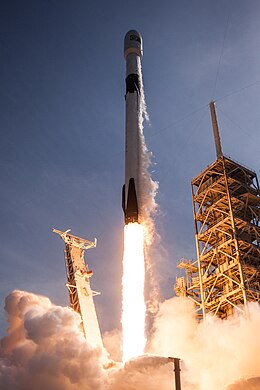 Launch of Bangladesh-1 | |
| Mission type | Communications and Broadcasting Satellite |
|---|---|
| Operator | Bangladesh Communication Satellite Company Limited |
| COSPAR ID | 2018-044A |
| SATCAT no. | 43463 |
| Website | Bangladesh Satellite Company Limited, BSCL , Bangladesh Satellite Project |
| Mission duration | 15 years |
| Spacecraft properties | |
| Bus | Spacebus-4000B2 |
| Manufacturer | Thales Alenia Space |
| Launch mass | ~3,709 kg (8,177 lb) |
| Power | 6kW |
| Start of mission | |
| Launch date | 12 May 2018, 20:14 UTC [1] |
| Rocket | Falcon 9 Block 5 (B1046.1) |
| Launch site | KSC LC-39A |
| Contractor | SpaceX |
| Orbital parameters | |
| Regime | Geostationary |
| Longitude | 119.1°E |
| Perigee altitude | 35789.3 km |
| Apogee altitude | 35798.5 km |
| Period | 1,436.1 minutes |
| Velocity | 3.07 km/s |
| Epoch | 6 June 2018 |
| Transponders | |
| Band | 14 C band, 26 Ku band |
| Bandwidth | 36MHz |
The Bangladesh Satellite-1 (BS-1) formerly known as Bangabandhu Satellite-1 (BS-1) is the first Bangladeshi geostationary communications and broadcasting satellite. It was manufactured by Thales Alenia Space and launched on 12 May 2018 from Kennedy Space Center, USA. [1] The satellite was the first payload launched by a SpaceX Falcon 9 Block 5 launch vehicle. [2] With the launch, Bangladesh became the 57th country to independently operate a satellite in space. [3]

